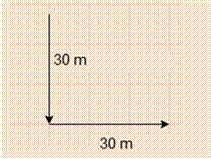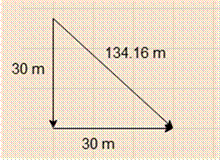
Concept explainers
Magnitude and direction of resultant displacement.
Answer to Problem 60A
Magnitude of displacement will be 134.16 m and direction will be
Explanation of Solution
Given:
First displacement of 30 due south and then 30 m due east.
Formula Used:
The resultant of two vectors is given by,
Here, P and Q are two vectors which are perpendicular to each other.
Calculation:
It is given first displacement is 30 m due south.
Let
And then 30 m due east.
Let
From the vector principle when two vectors are perpendicular to each other then their resultant magnitude is given by,
Magnitude of displacement by graphical method is shown below.
It is given first displacement is 30 m due south.
Therefore,

Then 30 m due east.
Therefore,

So the resultant displacement will be,

Now direction of displacement will be,
Therefore direction of displacement will be
As the magnitude of displacement is same by both mathematical and by graphical method.
Conclusion:
Therefore, magnitude of displacement will be 134.16 m and direction will be
Chapter 5 Solutions
Glencoe Physics: Principles and Problems, Student Edition
Additional Science Textbook Solutions
Genetic Analysis: An Integrated Approach (3rd Edition)
Human Physiology: An Integrated Approach (8th Edition)
Campbell Biology (11th Edition)
Introductory Chemistry (6th Edition)
Chemistry & Chemical Reactivity
Chemistry: Structure and Properties (2nd Edition)
- Draw the velocity vectors starting at the black dots and the acceleration vectors including those equal to zero.arrow_forwardYou toss a ball straight up by giving it an initial upward velocity of 18 m/s. What is the velocity of the ball 0.50 s after you released it? Define the positive y direction to be upward, the direction that you toss the ball.arrow_forward10:44 AM Fri Jan 31 O Better endurance Limb end points travel less D Question 2 Take Quiz 1 pt: Two springs are arranged in series, and the whole arrangement is pulled a vertical distance of 2 cm. If the force in Spring A is 10 N, what is the force in Spring B as a result of the displacement? 05N 5 N 0.2 N 10 N O2N Question 3 1 ptsarrow_forward
- What is the resistance (in (2) of a 27.5 m long piece of 17 gauge copper wire having a 1.150 mm diameter? 0.445 ΧΩarrow_forwardFind the ratio of the diameter of silver to iron wire, if they have the same resistance per unit length (as they might in household wiring). d. Ag dFe = 2.47 ×arrow_forwardFind the ratio of the diameter of silver to iron wire, if they have the same resistance per unit length (as they might in household wiring). d Ag = 2.51 dFe ×arrow_forward
 College PhysicsPhysicsISBN:9781305952300Author:Raymond A. Serway, Chris VuillePublisher:Cengage Learning
College PhysicsPhysicsISBN:9781305952300Author:Raymond A. Serway, Chris VuillePublisher:Cengage Learning University Physics (14th Edition)PhysicsISBN:9780133969290Author:Hugh D. Young, Roger A. FreedmanPublisher:PEARSON
University Physics (14th Edition)PhysicsISBN:9780133969290Author:Hugh D. Young, Roger A. FreedmanPublisher:PEARSON Introduction To Quantum MechanicsPhysicsISBN:9781107189638Author:Griffiths, David J., Schroeter, Darrell F.Publisher:Cambridge University Press
Introduction To Quantum MechanicsPhysicsISBN:9781107189638Author:Griffiths, David J., Schroeter, Darrell F.Publisher:Cambridge University Press Physics for Scientists and EngineersPhysicsISBN:9781337553278Author:Raymond A. Serway, John W. JewettPublisher:Cengage Learning
Physics for Scientists and EngineersPhysicsISBN:9781337553278Author:Raymond A. Serway, John W. JewettPublisher:Cengage Learning Lecture- Tutorials for Introductory AstronomyPhysicsISBN:9780321820464Author:Edward E. Prather, Tim P. Slater, Jeff P. Adams, Gina BrissendenPublisher:Addison-Wesley
Lecture- Tutorials for Introductory AstronomyPhysicsISBN:9780321820464Author:Edward E. Prather, Tim P. Slater, Jeff P. Adams, Gina BrissendenPublisher:Addison-Wesley College Physics: A Strategic Approach (4th Editio...PhysicsISBN:9780134609034Author:Randall D. Knight (Professor Emeritus), Brian Jones, Stuart FieldPublisher:PEARSON
College Physics: A Strategic Approach (4th Editio...PhysicsISBN:9780134609034Author:Randall D. Knight (Professor Emeritus), Brian Jones, Stuart FieldPublisher:PEARSON





